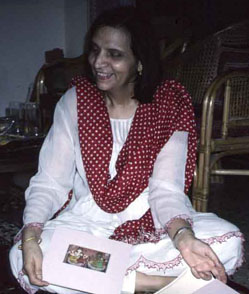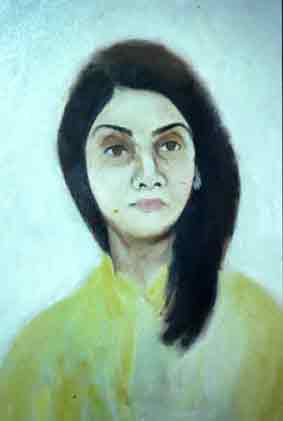Kishori Kaul
The Painter of Past Images and Present Impressions
"To verbalise the texture, hue, shadow
area and sudden burst of colour of a fleeting image imprinted on the mind's eye
is difficult at the best of times. To rediscover in words the gallery of images
that unfolds along the corridor of time is nearly impossible. What returns to
verbal language is mostly a montage, with large areas of association missing.
The perception and aesthetic assimilation of any visual experience do not even
return in words. They get into the colour technique and style and permeate the
artistic persona".
Kishori Kaul
Kishori Kaul was born in Srinagar in 1939. Her father
was a Kashmiri Pandit of unorthodox views serving in the Government. She studied
in Annie Besant School, Srinagar. The year 1953 was a year of great significance
for her. She fell ill with tuberculosis and while she lay tossing between hope
and disappointment, her grandfather, Narayan Mu, her grandmother whose father
was Narayan Muratgar, a celebrated painter of the late 19th century, placed
before her brush, colours and paper and thereby set the ball of aesthetic
sensibility rolling in her mind. No doubt, Kishori already had a penchant for
painting but now she got so engrossed in artistic work that she forgot about her
surroundings full of sorrows and sufferings with the result that she got cured
of her dreaded disease and, at the same time, emerged as a great painter. It was
a marvellous occupational therapy for her which brought a cataclysmic change in
her life and character.
 Kishori Kaul Kishori Kaul
Courtesy: Mag. Kapil Kaul
Her first teacher was Som Nath Bhat and then she joined
the Faculty of Fine Arts, M.S. University, Baroda in 1959. Soon herartistic
excellence was recognised and she got awards and prizes galore. She received
Bombay Art Society Award and Bombay State Award
(Poona). She also received Gujarat State Exhibition (Surat) Award. In 1963 she
received Bachelor of Fine Arts Degree with distinction and then in 1966 Master
of Fine Arts Degree, first class with distinction from Baroda University. In the
same year her father died.
Kishori exhibited her paintings in Srinagar, Bombay and
Delhi along with G.R. Santosh, Trilok Kaul, P.N. Kachru and others. In 1968 she
fell in love with and married Mr. Inder Varma, scientist and journalist. She has
held many exhibitions of her paintings in India and in foreign countries.
She generally works on canvas with oil and her
remarkable paintings
Garden (1989); 2. Green Fields, 1991; 3. Light Allover,
1991; 4. Lotus Lake, 1992; 5. Tree on Hill Side, 1992; 6. Gladioli, 1992; 7.
Amaltash, 1993; 8. Sunset, 1993; 9. Summer Flowers, 1993; 10. Srinagar, 1993;
11. Spring Amidst Snow, 1993; 12. Vegetables, 1993; 13. Autumn, 1993; 14.
Flowers, 1993; 15. Blue Lake, 1993; 16. Still Life with Samovar, 1993; 18.
Summer, 1993; 19. Reflections, 1993; 20. Gladioli in Vase, 1993.
There are three main characteristics in Kishori's
paintings. One, the pictures of her childhood in Srinagar are etched in her mind
and then by a magical trick she can associate the present with the past images.
She appears to have a mental camera in which are reflected and kept secure the
images of her earlier life. She lived her earlier life in Srinagar, Her house
was situated on the bank of the river Jhelum and she loved to watch the boats
floating on the surface of the water. She would also enjoy the quarrels of the
families of the boatmen. She had her deaf aunt who was quite eloquent in
narrating tales of wonder.
She remembered the songs of the peasants of her
mother's village where her parents lived and, according to Kishori, the sun, the
sky and the water and mountains would assume life and form. From another woman
she heard the stories of love and separation. All these experiences gave her
unique joy. Nothing seemed to depress her. She recalled with nostalgia the colour ofthe fields in Dal Lake when the
children were taken for a four or five days' picnic in a Doonga; the gold
spangled waters made her feel that she could walk on the surface; the needling
of petals into necklaces in Nishat as Kawa would be poured out of a samovar she
also well remembered.
 The fountainhead of her art lies in her childhood
experiences and the images she preserved in her mind. Her mother's guidance and
criticism in the beginning also helped her to fashion her work. Above all,
Nature was her great teacher. She writes: The fountainhead of her art lies in her childhood
experiences and the images she preserved in her mind. Her mother's guidance and
criticism in the beginning also helped her to fashion her work. Above all,
Nature was her great teacher. She writes:
"My process of conceiving a work is linked with
Nature's inherent structures and their ability to strike a deep resonance within
my memory. The downward rush of the crystalline water or a mountain stream,
splattered with light streaking through the overhanging branches of trees,
determines the structure of a painting...The sudden, swift flight of a bird, the
limb of a tree cutting across space, the little world of my garden in the middle
of the city-all become starting points for the reconstruction, through colour,
of fleeting but profound sensations".
Although Kishori has a photographic memory yet her art
creations are emotional representations of images and ideas. Her mind is biased
and it colours according to her emotional prejudice. If we contemplate on her
painting: "Earth, 1953", we see that there grow flowers all over the
earth of varied hues and then at the back are hazy hills and the few cottages
and the ground flooded with sunshine. It is an isolated piece of earth where
there is peace and calm. There is no room for sorrow, only beauty is sprinkled
all over. Kishori in this painting appears a mistress of colour and the lines
are misty. In her painting Kishori stands like a rock refusing to be carried
away by the tides of cheap commercial art.
If we see her another painting, "Still Life with
Blue Vase, 1993" we find that her painting reveals a whole gamut of colours
in many nuances and shades. This also confirms that Nature is the vast reservoir
of colour and beauty which provides her the inspiration. Her quest has been to
capture the evasive mystery of colour that she finds in the play of light on the
natural objects. Her landscapes, though instinctively belong to Kashmir, yet
they go beyond the topography of Kashmir but the contemplation; of the varying
moods of nature.
When we see Kishori's other paintings like, 'Lotus
Lake,' 'Green Fields,' 'Sunset,' 'Autumn;' 'Still Life with Samovar', we find
that she is a product of the social milieu and the environs of Kashmir determine
her basic consciousness. The evolution of varieties of landscape form created
out of soft line and delightful colour constitutes the essence of her art. She
has an extraordinary gift for colouring.
Kishori has now grown quite mature and it has now
become easy to assess her art and her predilections. Kishori Kaul cannot be
classed in one particular group. She has her own individual style based on her
earlier impressions and influences and keen observations of her environment cast
in the mould of her passionate imagination. She does not brood over the
miseries, personal or of others. There is not in her the attitude of Keats:
"O what can ail thee.../Alone and palely loitering?/ The sedge has withered
from the lake/And no birds sing," as we find in Ram Kumar. Her paintings
smile with vital lyricism. It appears as if her dreaded disease T. B. consumed
in its fever all her disappointments and hopelessness. That she has come out
quite healthy and free of the disease, has given her hope and thereby the proof
of Divinity. She succeeded in inviting exquisite sensitivity with a superbly
vigorous technique.
When we look at the face of Kishori herself we find her
sparkling eyes and gentle smile bespeak of her poetic temperament and the
optimistic attitude- "All is well with the world". This attitude is
diametrically opposite to Padma Sachdev's poetry, who, too, was suffering from
T.B. in her young age.
In the Amar Mahal is the picture of a woman, her two
braided tresses hang in front on both her sides. The face is only suggestive,
for it is misty. The lady appears reflecting on the pleasures of life. The
on-looker on contemplation of the picture is led to follow his own train of
ideas by the psychological process of association.
What is significant about Kishori, it may be repeated
for emphasis, is that she accepted Nature which became her inspirational source.
It may safely be insisted that her imagination had its roots in the observation
of Nature and her creations belong to a world never wholly divorced from
reality. Secondly, reminiscence stimulates her imagination and her most
beautiful landscape. Recently she has tried her hand on portraiture, which is
free from any semblance of imitations.
Source:
 The
Rich Heritage of Jammu and Kashmir The
Rich Heritage of Jammu and Kashmir
Studies in Art, Architecture, History
and Culture of the Region
By Prof. Somnath Wakhlu
Image Gallery:
http://ikashmir.net/gallery/categories.php?cat_id=117
|










 The fountainhead of her art lies in her childhood
experiences and the images she preserved in her mind. Her mother's guidance and
criticism in the beginning also helped her to fashion her work. Above all,
Nature was her great teacher. She writes:
The fountainhead of her art lies in her childhood
experiences and the images she preserved in her mind. Her mother's guidance and
criticism in the beginning also helped her to fashion her work. Above all,
Nature was her great teacher. She writes: The
Rich Heritage of Jammu and Kashmir
The
Rich Heritage of Jammu and Kashmir





No one has commented yet. Be the first!